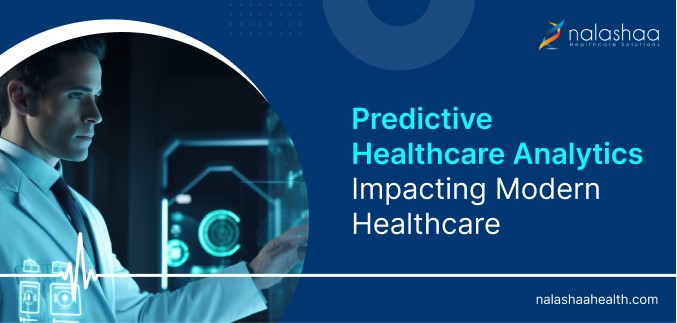Predictive Healthcare Analytics Impacting Modern Healthcare

Healthcare is constantly changing as data becomes central to how care is delivered. The amount of information available today reflects how diseases are identified, how treatment plans are tailored, and how hospitals manage their resources so that care teams work effectively.
Accurate insights are essential to improve patient care and address healthcare challenges today. The global predictive analytics market in healthcare, valued at $11.7 billion in 2022, is expected to grow at 24.4% CAGR through 2030 showing increasing adoption across the industry. Healthcare providers now use predictive models to forecast disease outbreaks, reduce hospital readmissions, and optimize treatment plans.
This blog examines predictive healthcare analytics, explaining what it is, how it works, and its applications. We’ll explore its benefits and challenges to understand why it is a core driver of change in modern healthcare.
What is predictive healthcare analytics?
Predictive healthcare analytics refers to the use of advanced data analytics techniques, such as artificial intelligence, machine learning, data mining, and statistical modeling, to forecast future health outcomes based on historical data. Unlike traditional analytics, which focuses on summarizing past events, predictive analytics anticipates trends and identifies potential risks in patient care.
Major data sources for predictive analytics include EHRs, insurance claims, medical imaging, and health surveys. For example, predictive tools can analyze patterns in patient records to determine the likelihood of hospital readmissions or assess medication adherence to predict chronic disease onset. This approach enables healthcare providers to deliver timely interventions.
How does predictive analytics work in healthcare?
Predictive analytics in healthcare follows three main steps, starting with data collection and moving toward actionable insights.
Data Collection
Information is gathered from various sources, including EHRs, patient registries, and administrative records. This creates a detailed dataset that forms the foundation for analysis.
Data Analysis
Algorithms are applied to detect patterns and trends. For example, models can analyze patient demographics and medical history to show potential health risks.
Prediction
The analyzed data helps forecast outcomes, such as identifying patients at higher risk for chronic conditions or determining which treatment plans are most effective.
Examples in action
- Identifying patients likely to be readmitted so follow-up care can be customized.
- Using historical data and machine learning to predict how patients may respond to specific therapies.
- Recognizing population health trends, such as predicting flu outbreaks in certain regions.
Applications of predictive analytics in healthcare
Predictive analytics addresses various healthcare challenges, benefiting patients, providers, and the broader population.
Supporting personalized care
Predictive analytics empowers doctors to design treatment plans that cater to individual needs. Insights from medical history, genetics, and other data points guide faster and more accurate decisions. This improves diagnoses and supports effective treatment choices tailored to each patient.
Monitoring population health
Predictive models help healthcare systems stay ahead of public health issues. Early warnings about disease outbreaks enable preparation and timely interventions. BlueDot’s detection of COVID-19 showcases the power of predictive analytics in safeguarding lives.
Reducing chronic diseases
Conditions like diabetes and heart disease are costly and complex to manage. Predictive analytics identifies individuals at risk by analyzing their lifestyle, medical history, and coexisting health issues. This allows for early intervention, leading to better health outcomes and lower costs over time.
Streamlining resources
Hospitals face challenges like staffing shortages and equipment downtime. Predictive analytics can help forecast patient admissions, refine staff schedules, and predict when medical equipment might require maintenance. These insights support smoother operations and improve care delivery.
Strengthening cybersecurity
The healthcare sector is increasingly targeted by cyberattacks. Predictive analytics identifies potential vulnerabilities, monitors system activity, and assigns risk levels to transactions. This helps reduce the likelihood of breaches, protecting sensitive patient information.
Examples of predictive analytics in healthcare
The impact of predictive analytics can be seen in its successful use across different healthcare scenarios:
Reducing readmissions
Corewell Health used predictive models to identify high-risk patients and provide personalized care after discharge. This approach saved $5 million and significantly reduced readmissions.
Detecting diseases early
Machine learning models predict conditions like Alzheimer’s and diabetes years before symptoms appear. For instance, researchers at the University of Massachusetts are working on a model to detect Alzheimer’s up to two years in advance.
Reducing appointment no-shows
A pediatric hospital in Chile used predictive analytics to identify patients likely to miss appointments. Targeted reminders reduced no-show rates by over 10 percent.
Maintaining equipment proactively
Hospitals analyze data to forecast when machines like MRIs need repairs. This minimizes service interruptions and keeps equipment running smoothly.
Understanding public health trends
Predictive analytics has been used to identify and respond to health threats. For example, tools have provided early warnings of disease outbreaks, helping organizations prepare more effectively.
Managing chronic diseases
By analyzing patient data, predictive models highlight individuals at risk for chronic conditions like diabetes or heart disease. Early action based on these insights improves outcomes and reduces costs.
Predictive analytics is already making a difference in healthcare by improving care delivery, saving resources, and addressing critical challenges.
Challenges in implementing predictive healthcare analytics
While predictive analytics holds significant promise, several obstacles can make its implementation difficult. Addressing these challenges is essential for its success in healthcare.
Clinician acceptance
Clinicians often face additional responsibilities when using predictive tools, such as updating electronic health records or interpreting dashboards. These tasks can compete with their focus on patient care, leading to hesitation or resistance. Involving clinicians during the development of these tools and incorporating their input can improve adoption. For example, the University of Pittsburgh Medical Center has seen better acceptance rates by engaging end-users throughout the process.
Ethical concerns and algorithm bias
Algorithms may reflect biases present in their training data, sometimes leading to uneven performance across populations. For example, some models may not work as effectively for minority groups, creating inequities in care. Transparency and fairness are critical. Developers can use explainable AI and conduct regular audits to minimize these risks and build trust among users.
Regulatory and legal challenges
The lack of clear regulations for healthcare AI introduces risks like inconsistent model performance and potential safety issues. Healthcare organizations must establish internal policies to monitor and validate predictive models regularly, ensuring reliable outcomes.
Data privacy and security
Healthcare data breaches are increasingly common, with over 82.6 million records exposed between January and October 2023. Protecting patient data requires robust measures, including encryption, monitoring, multi-factor authentication, and data governance in healthcare. Hospitals must also ensure compliance with HIPAA and other privacy standards to maintain trust and security.
Future of predictive healthcare analytics
Advances in AI, machine learning, and IoT are shaping the future of predictive analytics, opening new possibilities for healthcare.
Wearable technology
Wearable devices, such as fitness trackers and glucose monitors, offer new opportunities for real-time health monitoring. Data from these devices can help providers and patients address potential health issues early, such as irregular heart rhythms or sudden glucose changes.
Patient engagement
Predictive tools are helping patients become more proactive about their health by providing personalized recommendations and reminders. This level of engagement supports better outcomes and long-term wellness.
Global health preparedness
Predictive analytics is proving to be a valuable resource in identifying emerging health threats. For example, timely data analysis has enabled faster responses to outbreaks, helping healthcare systems prepare more effectively.
Predictive analytics continues to evolve, offering new ways to improve care and address global health challenges. Its future lies in the integration of advanced technologies and a patient-centered approach.
Conclusion
Predictive analytics helps healthcare providers anticipate challenges, improve patient care, and use resources more efficiently. While issues like algorithm bias, regulatory uncertainty, and data security risks need to be addressed, the advantages make it an important tool for modern healthcare.
Adopting predictive analytics is becoming essential for healthcare organizations. Whether it’s reducing readmissions, strengthening data security, or forecasting disease outbreaks, these tools enable smarter, proactive, and more personalized care.
Nalashaa’s Custom Software Development for Healthcare brings years of expertise in healthcare IT to help organizations harness the power of predictive analytics. From strategy and implementation to fine-tuning and optimization, our team ensures that your predictive models align with your goals and address your unique challenges. Let us guide you in delivering smarter, more proactive care while achieving better outcomes for providers, payers, and patients.
link




